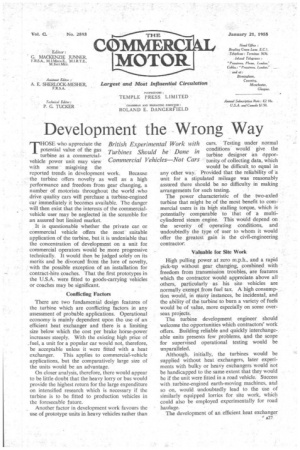Development the Wrong Way
Page 29

Page 30

If you've noticed an error in this article please click here to report it so we can fix it.
THOSE who appreciate the potential value of the gas turbine as a commercialvehicle power unit may view• with some misgiving the reported trends in development work. I3ecause the turbine offers novelty as well as a high performance and freedom from gear changing, a number of motorists throughout the world .who drive quality cars will purchase a turbine-engined car immediately it becomes available. The danger will then exist that the interests of the commercialvehicle user may be neglected in the scramble for an assured but limited market.
It is questionable whether the private car or commercial vehicle offers the most suitable application of the turbine, but it is undeniable that the concentration of development on a unit for commercial operators would be more progressive technically. It would then be judged solely on its merits and be divorced from the lure of novelty, with the possible exception of an installation for contract-hire coaches. That the first prototypes in the U.S.A. were fitted to goods-carrying vehicles or coaches may be significant.
Conflicting Factors There are two fundamental design features of the turbine which are conflicting factors in any assessment of probable appliCations. Operational economy is mainly dependent upon the use of an efficient heat exchanger and there is a limiting size below which the cost per brake horse-power increases steeply. With the existing high price of .fuel, a unit for a popular car would not, therefore, be acceptable unless it were fitted with a heat exchanger. This applies to commercial-vehicle applications, but the comparatively large size of the units would be an advantage.
On closer analysis, therefore, there would appear to be little doubt that the heavy lorry or bus would provide the highest return for the large expenditure on intensified research which is necessary if the turbine is to be fitted to production vehicles in the foreseeable future.
Another factor in development work favours the use of prototype units in heavy vehicles rather than British Experimental Work with cars. Testing under normal conditions would give the turbine designer an 0ppor Commercial Vehicles—Not Cars tunity of collecting data, which would be difficult to equal in any other way. Provided that the reliability of a unit for a stipulated mileage was reasonably assured there should be no difficulty in making arrangements for such testing.
The power characteristic of the two-axled turbine that might be,of the most benefit to commercial users is its high stalling torque, which is potentially comparable to that of a multicylindered steam engine. This would depend on the severity of operating conditions, and undoubtedly the type of user to whom it would offer the greatest gain is the civil-engineering contractor.
Valuable for Site Work High pulling power at zero m.p.h., and a rapid pick-up without gear changing, combined with freedom from transmission troubles, are features which the contractor would appreciate above all others, particularly as his site vehicles are normally exempt from fuel tax, A high consump tion would, in many instances, be incidental, and the ability of the turbine to burn a variety of fuels would be of value, more especially on some over seas, projects. The turbine development engineer should welcome the opportunities which contractors' work offers. Building reliable and quickly interchange able units presents few problems, and the scope for supervised operational testing would be unparalleled. Although, initially, the turbines would be supplied without heat exchangers, later experiments with bulky or heavy exchangers would not be handicapped to the same extent that they would be if the unit were fitted in a road vehicle. Success with turbine-engined earth-moving machines, and so on, would undoubtedly lead to the use of similarly equipped lorries for site work, which could also be employed experimentally for road haulage. The development of an efficient heat exchanger for road vehicles admittedly presents a complex problem. Low cost is essential, it must occupy the minimum of space and have a long service life. Efficient heat exchangers for large industrial and marine units have been built, but they are both bulky and costly, and some turbine designers consider that the production of a small practical exchanger will remain impossible. Such pessimism would be highly retrogressive if the prospect of failure retarded the development of the turbine proper. If a high fuel consumption proved to be the only bad feature amongst a host of economically sound virtues and if the fuel were not used for other types of power plant, some tax relief might eventually be granted.




























































































